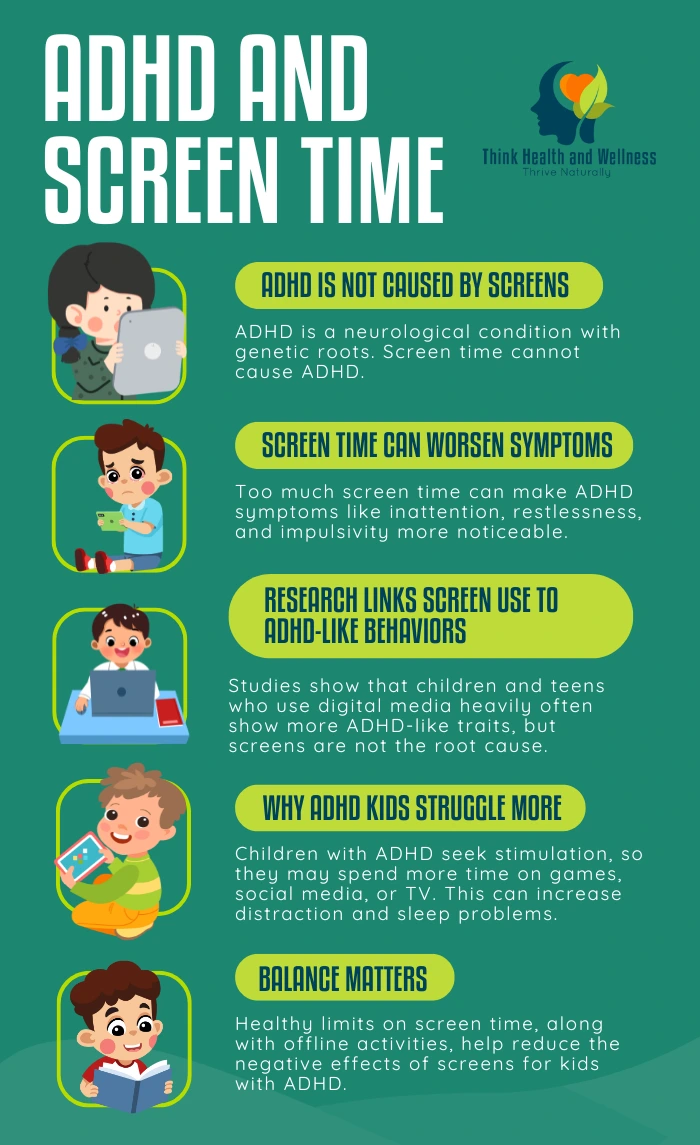Screen Time and ADHD: Could Screens Cause ADHD?

Yes—finger plays, clapping games, and dance routines that use hand gestures all help. Combine rhythm and repetition for deeper learning.
Send home simple activity ideas, kits, or worksheets. Offer short instructions and encourage family involvement. Regular practice builds lasting progress.
Try origami, sticker scenes, stringing pasta, or painting with Q-tips. Crafts that use small pieces build precision and control.
Many parents and educators ask: What's the link between screen time and ADHD? With children spending more time on devices, it’s natural to wonder whether technology use or screen dependency could actually cause ADHD. The answer is no—attention-deficit hyperactivity disorder (ADHD) is a neurological condition. Screens cannot create ADHD, but excessive digital media use can make symptoms more noticeable in children and adolescents, especially those already at risk.
What Is ADHD and What Causes It?

ADHD is one of the most common conditions diagnosed in childhood. It is driven by genetic and neurological factors, not by how much time in front of a screen a child spends.
Core symptoms of ADHD include:
- Inattention – difficulty focusing, being easily distracted
- Hyperactivity – restlessness, constant movement
- Impulsivity – acting without considering consequences
A child may be diagnosed with ADHD if these symptoms are severe and interfere with school, friendships, or family life. Childhood ADHD is biological in origin, but certain habits—like excessive screen use—can make symptoms appear stronger.
Genetic and Neurological Roots of Childhood ADHD
Research shows that ADHD often runs in families and is linked to differences in brain development. Studies highlight changes in areas responsible for executive functioning, such as attention, planning, and self-control. This confirms ADHD is inherited and neurological, not a disorder caused by technology use.
Can Screen Time Cause ADHD? Clarifying Misconceptions

Many worry that screen time can cause ADHD, but research shows otherwise. ADHD is not created by devices. However, screen time can lead to behaviors that resemble or worsen existing ADHD symptoms.
A 2018 study of over 2,500 high school students found that frequent use of digital media—such as social media, playing video games, or time on the computer—was linked with higher levels of ADHD-like traits. This suggests that heavy screen use may cause symptoms to intensify, though it does not prove screens directly cause ADHD.
Institutions like the Child Mind Institute, the American Academy of Pediatrics, and the National Institutes of Health agree: ADHD is neurological. But the effects of screen time can still be significant for kids who already live with ADHD.
How Screen Time Impacts Attention and Behavior

Too much technology use can affect focus, mood, and daily routines. Excessive screen time trains the brain to expect quick rewards—notifications, fast-paced games, or constant scrolling. This makes it harder to concentrate on slower activities like reading or homework.
For children and adolescents with ADHD, this impact is stronger. Screens don’t create ADHD, but they can worsen attention problems and disrupt healthy routines.
Gaming and Fast-Paced Media
Video games, social media, and rapid TV content keep the brain in a high-stimulation state. For individuals with ADHD, this can increase restlessness and irritability.
Why Kids With ADHD Struggle More
Because they naturally seek stimulation, kids with ADHD may spend even more time online. This raises the risk of screen dependency and makes it harder to manage executive functioning challenges like planning and self-control.
Risks of Excessive Screen Time in Kids and Teens

Impact on Childhood ADHD
For children already diagnosed with ADHD, too much screen time use makes it harder to manage symptoms. Prolonged computer use, smartphone use, or watching TV can increase the severity of ADHD symptoms, making schoolwork and family life more difficult.
Behavioral and Developmental Risks
During critical stages of adolescent health, balance is key. Teens with frequent digital media use may face more impulsivity, poor grades, or social struggles. These risks are particularly concerning for school students learning independence and responsibility.
Sleep, Mood, and Emotional Regulation
Screens—especially at night—interfere with sleep. Lack of sleep worsens ADHD traits. Overuse can also affect mood, leading to more frustration, anxiety, or sadness. The American Academy of Pediatrics recommends keeping devices out of bedrooms and setting limits to manage the effects of screen exposure.
Are There Any Benefits of Screen Time?

Not all screen time use is harmful. When balanced, technology can support learning, creativity, and connection. The key is guiding how children and adolescents use screens, rather than avoiding them completely.
Educational and Social Benefits of Technology Use
Technology use can offer valuable opportunities. Educational apps, online classes, and interactive tools help school students and kids with ADHD learn in engaging ways. For some children and adolescents with ADHD, structured digital programs can improve focus and organization skills. Socially, screens allow kids to connect with friends, practice communication, and even build supportive communities when guided appropriately.
Can Gaming Help Kids With ADHD in Positive Ways?
Although playing video games is often linked with excessive use, not all gaming is bad. Certain games can improve reaction time, problem-solving, and teamwork. For individuals with ADHD, positive gaming experiences may support attention skills, coordination, and even stress relief. When parents set limits on time per day, gaming can become a tool for growth rather than a source of attention problems.
You May Also Like: 10 Effective Ways to Help Kids Focus: Practical Tips for Parents
Practical Strategies for Parents and Caregivers

Managing screen time and ADHD is about setting healthy boundaries, not banning technology. With structure, parents can reduce the effects of screen time while still allowing kids to benefit from it.
Healthy Screen Time Limits for Children and Adolescents
The American Academy of Pediatrics recommends clear limits on time per day. For younger kids, keep time in front of screens short and focused on quality content. For students, balance screen use with outdoor play, homework, and family interaction. Tracking how much time your child spends on devices helps prevent excessive use and supports better mental health.
Teaching Balance: Tools, Schedules, and Family Tech Rules
To manage the effects of screen exposure:
- Create schedules – Set daily screen windows and stick to them.
- Use tech tools – Apps and parental controls can limit internet use or computer use automatically.
- Model healthy habits – Show kids that adults also balance technology use with offline activities.
- Encourage breaks – Remind kids to pause during playing video games or watching TV to rest their eyes and refocus.
- Set family rules – Keep devices out of bedrooms at night and limit smartphone use during meals.
When parents guide children and adolescents with ADHD, they can reduce the risk of screen dependency while keeping the benefits of technology.
You May Also Like: When Undisciplined Kids Grow Up: Why Habits Matter
Conclusion: ADHD, Parenting, and Technology in Perspective
ADHD is a neurological condition, rooted in genetics and brain development. It cannot be caused by screens or by how much time is spent in front of devices. However, excessive screen time can make ADHD symptoms worse, leading to more attention struggles, sleep problems, and emotional ups and downs.
Why ADHD Is Not Caused by Screens Alone
Research confirms that ADHD is not the result of technology use or “bad parenting.” Instead, screens may amplify challenges that already exist in children and adolescents with ADHD. This distinction is key, screens do not create ADHD, but screen time can lead to more noticeable attention problems when use is unchecked.
Using Tech as a Tool Instead of a Cause of ADHD
Parents and caregivers can guide kids with ADHD to use technology in positive ways, through educational apps, structured routines, and monitored social media or gaming. With limits on time per day and balanced offline activities, technology use can become a tool for learning and connection rather than a risk factor.
Bottom line: ADHD is not caused by screens. What matters most is how and how much technology is used. With healthy guidance, families can reduce risks and help children thrive in a digital world.
You May Also Like: Communication Skills for Kids: How to Help Your Child Communicate Better




